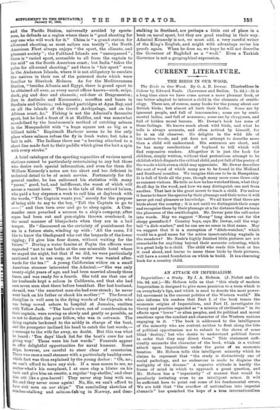C URRENT LITERATURE
THE BIRDS IN OUR WOOD.
The Birds in Our Wood. By G. A. B. Dewar. Illustrations in Colour by Edward Neale. (Lawrence and Bullen. Is. 6d.)—It is a long time since we have come across a more pleasant book, or one better adapted to interest a child in the elements of ornith- ology. There are, of course, many books for the young about our British birds ; but almost all have their faults. Some are by ignorant people, and full of inaccuracies ; some are by senti- mental ladies, and full of nonsense; some are by clergymen, and full of hidden moral lessons. Mr. Dewar's book has none of these failings. He knows much about wild birds, and what he tells is always accurate, and often noticed by himself, for he is an old observer. Ho delights in the wild life of his native woods, and yet does not attempt to describe more than a child will understand. His sentences are short, and he has many recollections of boyhood to tell which will find responsive readers. Altogether it is just , the book for children, simply written, without that pretentious attempt to be childish which disgusts the critical child, and yet full of the poetry of the woods which even a child may appreciate. Mr. Dewar describes the sort of wood of which many are to be found in the Midland and Southern counties. We imagine this one to be in Hampshire. It is full of birds all the year, though many more come there only as summer visitors. He tells us how he has watched them, what they do all day in the wood, and how we may distinguish one sort from another. That last is the great secret to teach a child. For unless it learns to know the species by their plumage and their notes it will never get real pleasure or knowledge. We all know that there are birds about the country ; it is not until we distinguish their songs and recognise them by their plumage at a far distance that we learn the pleasures of the ornithologist. Mr. Dewar, puts the call-notes into words. May we suggest " Meeay " long drawn out for the sleepy greenfinch ? Country boys, says Mr. Dewar, call the wag- tail "a dish-washer," and he can see no sense in that name. May we suggest that it is a corruption of "ditch-watcher," which would be a good name for the active insect-catching wagtails in the meadows? Mr. Neale's highly finished little pictures are not remarkable for anything beyond their accurate colouring, which is a great help to a child. The child who reads this book or has it read aloud, and learns to name these birds by their pictures, will have a sound foundation on which to build. It is a charming book for a country child.






















































 Previous page
Previous page